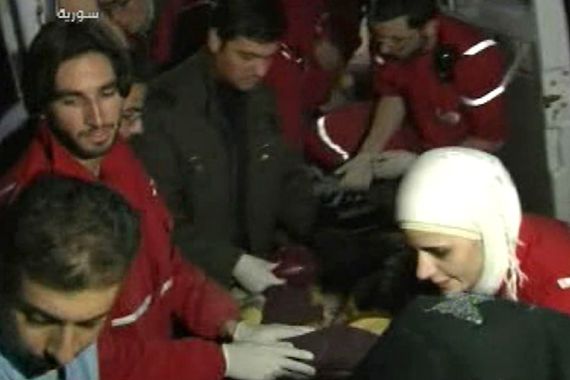Red Cross pushes to rescue wounded in Homs
Syrian Free Army blocks Syrian Red Crescent ambulances from entering area, in climate of “deep mistrust”.

The Syrian military has extended its bombardment of the opposition-held Bab Amr district of Homs into a fourth week as the Red Cross tried to negotiation the evacuation of more distressed civilians and foreign journalists from the city.
Scores of people were killed in Homs and elsewhere in Syria on Saturday, according to the Local Co-ordination Committees’ activist network. Sixteen soldiers and members of the security forces were also reportedly killed on Saturday.
The International Committee of the Red Cross (ICRC) said negotiations with the authorities and opposition groups to resume evacuations from Baba Amr, where two wounded Western journalists are trapped along with the bodies of two
killed colleagues, failed.
But ICRC spokesperson Saleh Dabbakeh said the Red Cross would pursue its efforts.
“[The] ICRC and Syrian Arab Red Crescent have been negotiating since this morning with both the Syrian authorities and opposition groups in Homs. The discussion has yielded no concrete result today. Unfortunately, therefore, no emergency evacuation will take place today,” he said.
“The ICRC and the SARC will continue to negotiate with the authorities and opposition in an attempt to enter Baba Amr and carry out life-saving evacuations.”
‘Deep mistrust’
A Western diplomat said the talks foundered because of “deep mistrust between the two sides” – the Syrian authorities and the opposition.
“This is making the negotiations very arduous,” said the diplomat.
Nadir Husseini, an activist in Bab Amr, said people in the neighbourhood were suspicious of the ICRC’s local partner, the Syrian Arab Red Crescent, and did not want to work with a group “under the control of the regime”.
The ICRC denied this, saying the Syrian Red Crescent was an independent organisation.
“Their volunteers are risking their lives on a daily basis to help everyone with no exceptions,” Hicham Hassan, ICRC spokesperson, said in Geneva.
The ICRC said the Syrian Arab Red Crescent had evacuated a total of 27 people from Bab Amr on Friday. On Saturday, it carried out two evacuations in other neighbourhoods in Homs.
The injured were taken to a privately owned local hospital, the Red Cross said.
A journalist involved in Saturday’s negotiations told the AFP news agency that ambulances entered rebel stronghold Baba Amr twice in the afternoon but were blocked by the Free Syrian Army.
“At one point they said they could not allow more evacuations, including those of foreign journalists, because nine people evacuated on Friday had been arrested,” she said on condition of anonymity.
She said the ICRC investigated the rebel claim and reported that the charge that evacuees had been arrested “were totally false”.
Journalists injured
US reporter Marie Colvin and French photojournalist Remi Ochlik were killed on Wednesday when a rocket hit a makeshift media centre in Baba Amr.
 |
| Edith Bouvier in an undisclosed location in Homs [EPA] |
Edith Bouvier, a 31-year-old freelance journalist for Le Figaro, the French newspaper, has two fractures in her femur.
The other surviving journalist, the British Sunday Times photographer Paul Conroy, escaped from the attack with minor leg injuries. On Thursday, Bouvier and Conroy appeared in a video posted on YouTube, asking to be evacuated for medical treatment.
A Syrian official, quoted by SANA state news agency, accused Baba Amr rebels of refusing to hand over Bouvier and the bodies of the journalists to rescuers.
“The concerned authorities in Homs, moved by humanitarian considerations, sent several local officials and Red Crescent ambulances to evacuate the Western journalists who entered Syria illegally,” the official said.
“Despite efforts that lasted several hours, armed groups in Baba Amr refused to hand over the wounded woman [Bouvier] and the two bodies, thus endangering the life of the wounded French journalist.”
Hundreds wounded
Civilians have reported desperate conditions in Bab Amr.
“We have hundreds of wounded people crammed into houses,” Husseini, the activist, said. “People are dying from lack of blood because we just don’t have the capability of treating everyone.”
The Tunis conference was intended to increase diplomatic pressure on Assad to end an almost year-long crackdown on opponents of his 11-year rule in which thousands of Syrians have been killed.
Hillary Clinton, the US secretary of state, said Assad would be held to account for the bloodshed and sharply criticised Russia and China, which have blocked any UN measures against Syria.
But to beleaguered Syrians the speeches seemed remote.
A doctor in the restive town of Zabadani said: “I’m really frightened that after all these efforts we will still end up like Hama in 1982, killed while the world waits and watches.”
Assad’s father crushed an armed Islamist uprising in Hama 30 years ago, killing many thousands of civilians and razing parts of the city with tanks and artillery in a three-week assault.
“The people of Zabadani resent what happened in Tunis,” the doctor, who asked not to be named, said. “We need them to arm the revolution. I don’t understand what they are waiting for. Do they need to see half the people of Syria finished off first?”
Diplomacy is hamstrung because Russia and China, which did not attend the Tunisia meeting, oppose Security Council action and there is little appetite for military intervention in Syria.
In Bab Amr, activist Husseini said he had “lost faith in everyone but God”, but the uprising would go on regardless.
“The shelling is just like it was yesterday. We have had 22 days of this. The women and children are all hiding in basements,” he said, his words tumbling out in anger.
“No one would dare try to flee the neighbourhood, that is instant death. You’d have to get past snipers and soldiers. Then there is a trench that surrounds our neighbourhood and a few others. Then you have to go past more troops.”